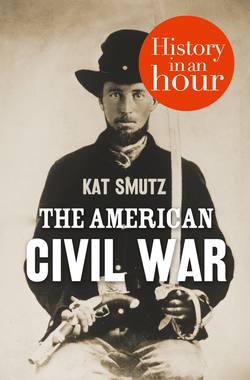Читать книгу The American Civil War: History in an Hour - Kat Smutz, Kat Smutz - Страница 5
ОглавлениеIntroduction
The Confederate States can no longer delay assuming actual possession of a fortification commanding the entrance of one of their harbors.
Brigadier General P. G. T. Beauregard to Major Robert Anderson, Charleston, South Carolina, 11 April 1861
It was early on a Friday morning in the spring of 1861 that the American Civil War began. At 4.30 a.m. on 12 April, Confederate forces in Charleston Harbor, South Carolina, were ordered to open fire on Fort Sumter where Union forces were entrenched. The State of South Carolina had led the way in seceding from the Union, and had been joined by several other slave states in forming a separate government called the Confederate States of America. But the United States and its new president, Abraham Lincoln, refused to recognize the Confederacy as a country, and refused to withdraw Union troops from Southern positions, including the one in Charleston Harbor. Confederate commander Brigadier General P. G. T. Beauregard had sent word to Union commander Major Robert Anderson advising him that he and his troops must leave. When Anderson refused, Beauregard’s troops opened fire. The next day, a Saturday, the Union commander, Major Robert Anderson, knew that he was outnumbered, out of food and out of options. The first engagement of the American Civil War had been fought, and the Confederate States of America was the victor. More than 40,000 shells had been dropped on the fort that sat on a spit of land in the harbour, and yet there were few wounded and no casualties.
The bombardment of Fort Sumter was the first actual engagement between Union and Confederate forces, and is considered the official beginning of the American Civil War. However, the storm clouds of conflict had been gathering for some time before those first shots were fired. When the First Continental Congress presented their Declaration of Independence to the country in 1776, it included the promise of ‘life, liberty, and the pursuit of happiness.’ They neglected to mention that the promise was limited to white males. But it didn’t go unnoticed.
Despite the resistance to the inequality inherent in the Declaration of Independence, the US president, Abraham Lincoln, went to war not for the benefit of slaves or in support of the cause of abolitionism, but for the preservation of the Union.
Four years later, the war was won, the Confederate States of America had ceased to exist, and through Lincoln’s Emancipation Proclamation, slaves were free. But peace had come at a high cost and to this day the American Civil War remains the bloodiest conflict in America’s history. And with the end of the war came the difficult years of Reconstruction. Lincoln was dead, felled by an assassin’s bullet, the South lay in ruins and the legacy of conflict would affect the US for decades to come.
This, in an hour, is the American Civil War.
